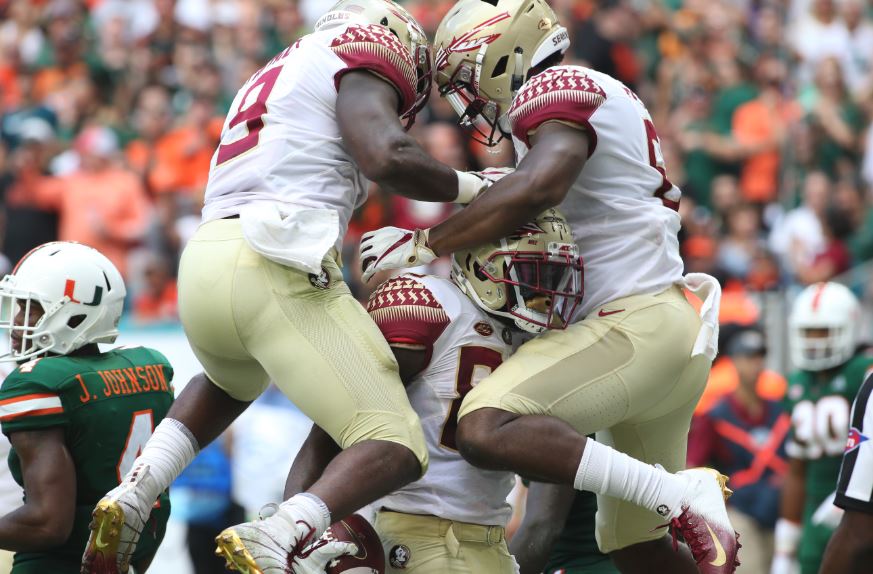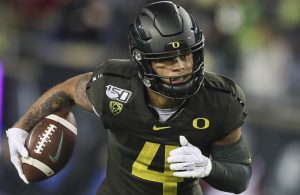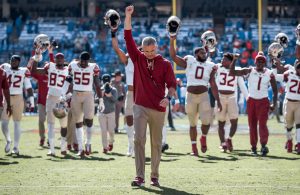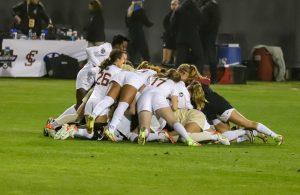- Sunday Seminole Summary: FSU Football Adds Pair of WR Transfers
- Sunday Seminole Summary: FSU Football Exits ESD With Top-15 Class
- Sunday Seminole Summary: FSU Soccer Tops BYU for Third National Championship
- Sunday Seminole Summary: FSU Soccer Advances to National Championship Match
- Seminole Sunday Summary: FSU Soccer Heads Back to College Cup
- Seminole Sunday Summary: FSU Soccer Reaches Sweet 16; Football Tops Boston College
- Seminole Sunday Summary: FSU Soccer Wins ACC, Advances to Second Round of NCAA Tournament; FSU Football Rallies Past Miami
- Seminole Sunday Summary: FSU Soccer Tops Wake on OT to Advance to ACC Final
- Seminole Sunday Summary: FSU Football Crushes UMass for Third Straight Win
- Seminole Sunday Summary: FSU Soccer Stays Perfect with Pair of Wins
Grading FSU Offensive Position Groups Through Six Games
- By Clint Eiland
- Updated: October 9, 2018
 Bill Pearce/FSU athletics
Bill Pearce/FSU athleticsFlorida State football now has the bye week to try and recover from Saturday’s loss to Miami — both physically and mentally. The Seminoles have improved over the past few games, but their record still stands at 3-3 with difficult opponents ahead. If they want to make a bowl game, they’ll need to iron out the remaining deficiencies and play with the same effort they did against Miami.
Since the bye week falls on a nice midway point of the season, we’re going to be examining and grading each position group over the next couple of days. Today, we’ll be looking at the offensive side of the ball. The most maligned part of the team showed life against the Hurricanes, but overall their performance this season has been mightily disappointing. We give some insight on why that might be.
We will try to point out which players from each position group have succeeded and which have struggled. A position’s grade should not be used as an assessment of individual play.
Quarterback (C-)
The obvious conclusion midway through the season is that redshirt junior Deondre Francois is a boom-or-bust quarterback. The numbers initially appear kind to him: Francois is throwing for a career-high 61 percent completion rate, he’s averaging a fine 7.1 adjusted yards per attemot, 251 yards per game, and he’s put up 13 touchdowns to just six interceptions. What’s not to like?
As always, there’s more to the story. Francois’ stat totals are somewhat inflated by singular efforts. His games against FCS team Samford, Northern Illinois, and Louisville have accounted for 65 percent of his yardage and nine of his 11 passing touchdowns. Against all other opponents, he has been much less impressive, averaging only 180 yards through the air and only throwing for two touchdowns, compared to five interceptions.
Those who have watched every game understand the discrepancy. Francois struggles with option plays and has yet to improve his decision making in this regard. It hampers an offense that is already doing what it realistically can with an offensive line racked by injuries and lack of depth.
Francois also seems to hit major cold streaks where he misses open receivers with wildly inaccurate passes. The second half against Miami was probably the most glaring instance yet, where Francois had open receivers at various levels of the field, but couldn’t connect with hardly any of them.
At this point, head coach Willie Taggart may need to reevaluate the quarterback room and consider what sophomore James Blackman can do. Francois simply has not improved enough to justify keeping him as the unquestioned starter.
Running Backs (C+)
This position is much more reliant on the offensive line than either quarterback or wide receiver, so it’s difficult to accurately grade them. The two main factors you can observe are their blocking, their willingness to hit gaps, and the various other intricacies of the position. Because as long as the offensive line is in this condition, you can’t judge them on their production.
With that being said, running backs Cam Akers and Jacques Patrick have been a mixed bag so far. For the first few games, Akers was struggling mightily with finding the holes in the blocking. Some of it was bad offensive line play, but Akers absolutely did not help out the unit with his dancing in the backfield. He spent far too much time looking for a home run, when he should’ve been looking for a single. He’s improved on it considerably since then, and seemed more comfortable against the Hurricanes.
Patrick has been the more consistent of the two, even if it hasn’t translated to volume stats. He’s been more patient with the line and is the more reliable option when needed positive yardage. He’s also stepped up as a pass blocker when given the opportunity.
This is probably as good as they can play within the current offensive limitations. They need to build off the Miami game and come to each contest with similar effort and mindset.
Wide Receiver (B-)
After the Virginia Tech and Samford games, this unit should’ve drawn more ire than it did. They couldn’t block worth anything, they acted confused on the field when trying to go up-tempo, and they weren’t winning 1-on-1 match-ups with any sort of consistency.
Since then, they have come out and played much cleaner football. The blocking is getting there, and the success of screen plays should be evidence enough. Instead of confusion and arguing while driving down the field, the receivers get in to formation quickly and are finally starting to stress defensive secondaries. Position coach David Kelly has done an impressive job of correcting the issues.
Most impressive is Tamorrion Terry, who realized that his combination of size and speed makes him virtually uncoverable. He’s averaging over 20 yards per catch and leads the team with five touchdowns. Keith Gavin had another encouraging game against Miami where he scored his first career touchdown on a contested ball. For the past two seasons, he hasn’t won those battles.
Tre’ McKitty, a sophomore tight end, has taken a backseat in recent weeks thanks to his duties as a blocker, but he might be the most underrated of the bunch. He’s a valuable option in the middle of the field and even forced Miami’s talented linebacker corps into unfavorable situations. His blocking has also made the offense run smoother.
The only player who is truly difficult to judge is Nyqwan Murray. On one hand, he’s the leading receiver who almost single-handedly won the Louisville game, as well as putting together a solid performance against Virginia Tech. Yet the same issues that plagued him under Jimbo Fisher have plagued him in the new offense. He’s liable to take plays off for long stretches of the game, and he’s always trying for a massive gain instead of taking the yards presented to him. He’s more frustrating than he needs to be, and that’s why he comes out looking a bit worse than his teammates.
Offensive Line (D-)
Why not an F? Because injuries are unpredictable and various factors need to be weighted differently when examining an offensive line that didn’t have depth in the first place. We’re not school teachers after all. We can bend the rules a bit.
The best performers from this group include a mix of Landon Dickerson, Cole Minshew, and Brady Scott. Dickerson’s injuries are a major negative for the offense, while the other two have thankfully stayed mostly healthy. Minshew’s run blocking picked up right where he left off, even if the pass blocking has been sub-par.
Brady Scott won’t be winning any awards this season, but he has stepped up at right tackle and become a competent lineman. Remember that he was a very raw prospect coming out of high school and he’s only been in the program for one year. The fact that he’s already better than Jauan Williams — despite being at FSU for less time — is worth noting.
Beyond that…it’s not pretty. Center Alec Eberle reached his ceiling a while back and simply can’t go toe-to-toe with better linemen in the ACC. He’s average at best. Abdul Bello and Mike Arnold are fairly interchangeable since neither makes much of a difference. Derrick Kelly’s injuries destroyed his flexibility and make him either an average guard or a below average tackle. Arthur Williams is an OK player who shows potential when given the opportunity, but his late switch to the position means he’s learning on the fly.
Breaking it down player-by-player can be deceptive since the group has to be cohesive. Well, they don’t grade out very well in that regard. Fans want to point to technique or effort, and that certainly plays a part in how a few players have performed. But overall? They just aren’t that talented. It’s year three or four for some of these guys, and they couldn’t win match-ups with Samford. Nobody wants to hear about untapped potential at that point. For now, this offensive line is going to be one of the worst in the Power 5, and it’ll stay that way the rest of the season.




You must be logged in to post a comment Login